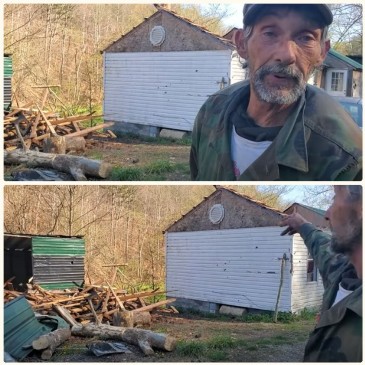VIEWS EXPRESSED BY CONTRIBUTORS IN COLUMNS/OPINION EDITORIALS ETC.. ARE THOSE OF THE AUTHOR(S) AND DO NOT REPRESENT THE VIEWS OR OPINIONS OF CLAYCONEWS
Op-Ed by Chris Woolery, Energy Projects Coordinator at Mountain Association
Submitted by Ariel Fugate, Mountain Association
“This Op-Ed was originally submitted by Ariel Fugate on behalf Chris Woolery at Mountain Association. ClayCoNews edited and expanded the piece to include local context, such as the May 16, 2025, tornado and the Marcum Ray Adams story. The views expressed are those of the author and do not necessarily reflect those of ClayCoNews.”
LONDON, KY – May 20, 2025, 12:23 PM EDT – Eastern Kentucky faces unrelenting challenges. The decline of coal, the opioid crisis, and the EF-4 tornado that claimed 19 lives in Laurel, Pulaski, and Russell Counties on May 16, 2025, have left deep wounds.
Just 25 miles away, a wind gust in March 2025 crushed the home of Marcum Ray Adams and his family on Curry Branch Road, off Highway 80 west of Manchester in Clay County, highlighting the region’s vulnerability to storms.
For low-income families in Clay, Laurel, and beyond, the Low-Income Home Energy Assistance Program (LIHEAP) is a lifeline, helping them afford heating and cooling amid rising utility bills. Yet, the Trump administration’s proposed 2026 federal budget eliminates LIHEAP, a move that could devastate our region’s most vulnerable, especially as they recover from these disasters.
LIHEAP provides one-time grants—up to $250 per season—to help 219,000 Kentucky households avoid choosing between food and heat, medicine and air conditioning. In 2024, it supported families in counties like Laurel, where the tornado left 25,000 without power, and Clay, where storm damage strained resources. For rural residents in older, less efficient homes, utility bills can consume 14.5% of income—over twice the 6% “high” energy burden threshold. LIHEAP’s weatherization efforts, improving over 60,000 homes nationwide in 2023, reduce these costs, offering lasting relief.
The administration claims lower energy prices from “American energy dominance” will ease burdens, but Eastern Kentucky families face rising bills today. Kentucky is one of 10 states allowing utility shutoffs during extreme weather, sometimes for debts as low as $6. LIHEAP prevents these crises, supporting households with elderly members, young children, or health conditions—common in storm-ravaged communities like Findley Trailer Park.
Kentucky received $54 million in LIHEAP funds in 2025, administered by Community Action Kentucky. Eligible households, with incomes up to 150% of the Federal Poverty Guidelines, can apply through local agencies like the Laurel County Community Action Agency until May 30, 2025, for cooling assistance. Yet, the proposed budget cut threatens this safety net, ignoring the systemic challenges of poverty, job loss, and disasters in Appalachia.
As London mourns victims like firefighter Roger Leslie Leatherman and horticulturalist Tiffany Heim, and Clay County recovers from storms, LIHEAP’s role in survival is undeniable. Watch Marcum Ray Adams share his brush with death in the Curry Branch Road storm damage video here:
Cutting LIHEAP isn’t just a budget choice—it’s a blow to our communities. Share your LIHEAP story to show why this program matters.
Photo and video courtesy of ClayCoNews.
Chris Woolery is the Energy Projects Coordinator at Mountain Association. He has helped deliver energy efficiency upgrades to over 800 households. Reach him at .
Please consider supporting our local coverage at the following link: ClayCoNews since 2004! HELP keep it FREE! Thank you very much!












